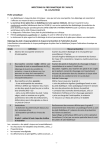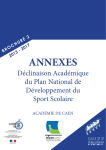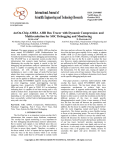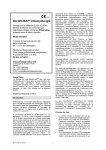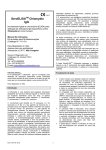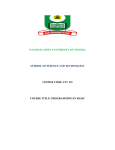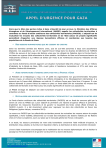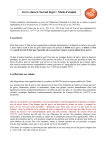Download A/HRC/17/29/Add.1 - Office of the High Commissioner for Human
Transcript
A/HRC/17/29/Add.1 United Nations General Assembly Distr.: General 13 May 2011 English/French/Spanish only Human Rights Council Seventeenth session Agenda item 3 Promotion and protection of all human rights, civil, political, economic, social and cultural rights, including the right to development Report of the Special Rapporteur on the right to education, Kishore Singh Addendum Communications sent to and replies received from States* * The present report is circulated as received. GE.11-13206 A/HRC/17/29/Add.1 Contents 2 Paragraphs Page I. Introduction............................................................................................................. 1–6 3 II. Communications sent and replies from States......................................................... 7–117 3 China (People’s Republic of) .................................................................................. 7–16 3 Colombia ................................................................................................................ 17–25 5 France...................................................................................................................... 26–67 6 India ........................................................................................................................ 68–72 12 Israel........................................................................................................................ 73–81 12 Romania ................................................................................................................ 82–107 13 United States of America ........................................................................................ 108–116 17 A/HRC/17/29/Add.1 I. Introduction 1. The present addendum to the report of the Special Rapporteur on the right to education contains, on a country-by-country basis, summaries of joint and individual letters of allegations and urgent appeals transmitted to States between 1st March 2010 and 29 April 2011, including communication sent by the previous mandate holder until 31 July 2010, as well as replies received between 15 April 2010 and 29 April 2011. Observations made by the Special Rapporteur have also been included where applicable. 2. The Special Rapporteur receives information alleging violations of the right to education and related rights from national, regional and international non-governmental organizations, as well as intergovernmental organizations. The Special Rapporteur responds to information received and considered to be reliable on alleged violations of the right to education, by writing to the State and others actors concerned, either together with other special procedure mandates or alone, inviting comment on the allegation, seeking clarification, reminding them of their obligations under international law in relation to the right to education and requesting information, where relevant, on steps being taken by the authorities to redress the situation in question. The Special Rapporteur urges all States and other actors to respond promptly to his communications and, in appropriate cases, to take all steps necessary to redress situations involving the violation of the right to education. 3. The Special Rapporteur recalls that in transmitting allegations and urgent appeals, he does not make any judgement concerning the merits of the cases, nor does he support the opinion of the persons or actors on behalf of whom he intervenes. The Special Rapporteur draws attention to the fact that the issues reflected in this addendum are not representative of the wide range of issues encompassed by the right to education. 4. Owing to restrictions on the length of documents, the Special Rapporteur has considerably reduced the details of communications sent and received. To the extent that his limited resources permit, the Special Rapporteur continues to follow up on communications sent and to monitor the situation where no reply has been received or where questions remain outstanding. 5. During the period under review, the Special Rapporteur transmitted 7 communications to the Governments of 7 States: China, Colombia, France, India, Israel, Romania and United States of America. 6. Five responses to these communications were received. The Special Rapporteur regrets that some States failed to respond and thanks those which took the time and made the effort to provide replies, which are reflected in the present report. II. Communications sent and replies from States China (People’s Republic of) Communication sent 7. On 22 October 2010, the Special Rapporteur on the right to education, the Independent Expert in the field of cultural rights, Special Rapporteur on Contemporary forms of racism, racial discrimination, xenophobia and related intolerance and Independent Expert on minority issues sent a joint urgent appeal to the Government of China regarding allegations relating to restrictions imposed on the use of the Tibetan language in schools in the Tibetan Autonomous Prefecture of China. 3 A/HRC/17/29/Add.1 8. According to information received, proposed educational reforms in the Tibetan Autonomous Prefecture stipulated that all subjects previously taught in both Chinese (Mandarin) and Tibetan languages, would in future be taught only in Chinese, except for Tibetan language classes. In addition, the educational reforms would allegedly result in a Chinese-only curriculum and that all textbooks would be in the Mandarin Chinese language only. Under a policy of bilingual education in the regions, lessons had previously been conducted in both languages and textbooks available in Tibetan and Chinese. According to the information provided, such reforms were underway and had already been implemented in some parts of the Tibetan Autonomous Prefecture, including Gansu province. Reportedly no consultation had been held with the affected communities and, under instruction from provincial authorities, Tibetan teachers had been required to attend workshops on the change of the medium of instruction from Tibetan to Chinese. 9. According to the information received, such alleged restrictions on the use of the Tibetan language in schools would have a negative impact on those of Tibetan origin and the preservation and promotion of the Tibetan language generally. Concerns related to the impact of the education reforms on the education outcomes as well as to access to their cultural heritage of children whose mother tongue language was Tibetan. Those children had benefitted from bilingual education that had enabled them to become proficient in both languages, ensuring access to their own cultural heritage. In addition, concern existed that the new education policy will result in Tibetan teachers losing their jobs as the Tibetan language was phased out and became redundant in schools. Secondary education was taught only in Mandarin and university entrance exams were conducted in Mandarin resulting in Tibetan students reportedly being put at a disadvantage. Concerns had been expressed by community leaders regarding the long-term negative affects of such education reforms on the preservation of the Tibetan language and Tibetan culture in the region if these reforms were to be put into practice. 10. Allegedly owing to this decree, on 19 October 2010 in Tongren (Rebkong in Tibetan) county in Malho, Tibetan Autonomous Prefecture, in Qinghai province, thousands of Tibetan students had reportedly come out on the streets to protest against the education reforms and the inequality faced by the Tibetans. Further student demonstrations had been reported on 20 October at various towns in the Hainan (Tsolho in Tibetan) Tibet Autonomous Prefecture in western Qinghai province, according to sources. Protesters were reportedly calling for equality between ethnic groups and for the Tibetan language to maintain its status as one of the two languages of instruction in the education system in the region’s bilingual education. In all cases the protests had been described as peaceful and, to-date, there had been no reports of clashes between demonstrators and police or arrests. Response received 11. On 18 November 2010, the Government replied to the urgent appeal sent on 22 October 2010. The Chinese Government indicated that it had carefully looked into the matter referred to in the communication and wished to make the following reply: 12. China’s Constitution, the Law on Regional National Autonomy, the Education Law and the Law on the National Language and its Writing all contain clear provisions with regard to the teaching of written and spoken language. The Chinese Constitution clearly stipulates that the language in common use throughout the country shall be popularized; this is done because of the existence of many ethnic and local languages, just as it is done in countries with numerous ethnic groups the world over. The Chinese Constitution further stipulates: “people of all nationalities have the freedom to use and develop their own spoken and written languages”, while the Law on National Regional Autonomy and relevant local and autonomous legislation also contain provisions that are even more detailed and specific. 4 A/HRC/17/29/Add.1 13. The vigorous development of education in minority languages through bilingual education in minority areas has long been one of China’s policies. Bilingual education in China has been developed extensively through more than a half century of effort, and has been instituted in basic through tertiary education. The State attaches a high degree of importance to the protection and transmission of minority languages in both their spoken and written forms. In 2009, the State Council issued its views on the development of the cultural activities of ethnic minorities, setting out a number of policy measures which included increasing Government investment in such activities, giving priority to increasing the publication of materials in minority languages as well as the translation of minority languages, and protecting and developing minority languages by promoting their standardization and their adaptation for use with electronic information technology. 14. In September 2010, Qinghai Province held a province-wide education conference at which the outline of the Provincial Plan for Medium-term Educational Reform and Development 2010–2020 was presented; one of the key elements of the Plan was strengthening and reforming bilingual education as a means of promoting education in minority areas. The Plan called for the following: in future, bilingual education in Qinghai would emphasize the language in common use throughout the country while providing education in ethnic minority languages, so that minority students would be proficient in their knowledge and use of both the language in common use in the country and their own minority language. This is consistent with national legislation and necessary for the growth and development of minority students. In Tibet and every autonomous Tibetan locality, both Tibetan and Chinese are the languages of instruction in schools; there are also, where there is a need, specialized Tibetan-language schools, where spoken and written Tibetan are used extensively. The operation of “bilingual schools” is not intended to target any particular minority group, nor is it intended to diminish the status of minority languages, but rather enhances communication between all ethnic groups as well as the employment prospects and long-term development of minority students. It is also consistent with national legislation and in the interest of the masses. 15. In October 2010, a few students from some schools in Qinghai held public demonstrations; upon investigation it was determined that the main reason for the demonstrations was that the students had misunderstood the plan for reforming and strengthening bilingual education that had been proposed at the Qinghai education conference. Following this incident, the Qinghai provincial government and education authorities at all levels promptly met with students and teachers to publicize the State’s minority education policy, listening extensively to the views and opinions of teachers, principals and students. People from all ethnic groups as well as teachers and students gained a fuller understanding of the significance of bilingual education and the provincial government’s policy in that area. Today the matter has been resolved satisfactorily, and the situation in the schools has quickly returned to normal. Throughout these events no student who participated in the demonstration was arrested, detained or charged with criminal acts. Observations 16. The Special Rapporteur would like to thank the Government for its reply. Colombia Comunicación enviada 17. El 3 de Agosto de 2010 el Relator Especial sobre el derecho a la educación envío una carta de alegaciones al Gobierno de Colombia sobre los impactos negativos causados por la Resolución 5443, sancionada por el Ministerio de Educación Nacional de Colombia el 30 de junio de 2010. Dicha Resolución define las características de los programas de 5 A/HRC/17/29/Add.1 formación en Educación y determina que la formación en algunas modalidades de atención educativa a poblaciones específicas sea suministrada únicamente como postgrado opcional. 18. De acuerdo con los informes recibidos: El 30 de junio del corriente año, la actual Ministra de Educación Nacional, Sra. Cecilia Vélez White, firmó la Resolución 5443, que en el Artículo 3, punto 4 resuelve que: 19. “Para las demás modalidades de atención educativa a poblaciones, señaladas en el Título III de la Ley 115 de 1994 y en el Decreto 366 de 2009 o las normas que las sustituyan y en las demás normas vigentes, la formación de docentes se adelantará en programas de postgrado en educación”. 20. Se alega que la sanción de la Resolución 5443 conllevaría la desaparición de la formación inicial de algunos títulos de pregrado, por ejemplo la formación de los educadores especiales y comunitarios, los educadores rurales y campesinos; y los pedagogos sociales y reeducativos. Estos educadores tienen la responsabilidad de formar a las personas con limitaciones o capacidades excepcionales, a los adultos, a los grupos étnicos, a los trabajadores rurales y campesinos; y a los individuos que necesitan rehabilitación social, de acuerdo con el Título III de la Ley General de Educación. 21. La información llegada a mi atención indica que la formación de educadores sociales y especiales quedaría relegada a la educación superior terciaria, la cual es una oferta opcional temporal y adicional a la formación docente preescolar, primaria y secundaria. Consecuentemente, la Resolución 5443 convertiría a la formación de profesionales idóneos para la educación de las poblaciones previamente mencionadas en una opción y no en un deber de las instituciones universitarias. 22. Según los informes recibidos, la Resolución desfavorecería la formación inicial de alta calidad de profesionales idóneos de la educación para personas marginadas, discriminadas y con debilidades manifiestas, y de tal manera contraviene el derecho a la igualdad y a la protección especial de estas mismas personas. Comunicación recibida 23. Mediante comunicación datada del 21 de Octubre de 2010, el Gobierno contestó a la comunicación enviada por el Relator Especial el 03 de Agosto de 2010. 24. El Gobierno informó que el Ministerio de Educación Nacional, reconociendo las implicaciones sociales y legales del artículo 3º de la Resolución 5443, en el 06 de agosto de 2011 expidió la Resolución 6966, la cual modifica la Resolución 5443 en su artículo 3º sobre denominación académica del programa y titulación y su articulo 6º relacionando con la practica pedagógica. Observaciones 25. El Relator Especial agradece al Gobierno de Colombia por su respuesta. France Communication envoyée 26. Le 23 avril 2010, le Rapporteur spécial sur le droit à l’éducation, conjointement avec la Rapporteuse spéciale sur la situation des défenseurs des droits de l’homme et le Rapporteur spécial sur les droits de l'homme des migrants a envoyé une lettre d’allégation sur la situation de MM. Claude Didier et Rémi Riallan, directeurs d’écoles dans le département de l’Isère et de Mme Claudia Chiaramonti et de M. Colin Sanchez, directeurs d’écoles dans le département de Vaucluse, ainsi que sur la mise en oeuvre du logiciel de 6 A/HRC/17/29/Add.1 données « Base-élèves premier degré» au sein de l’Education nationale. MM. Didier et Riallan ont fait l’objet d’une lettre d’allégations envoyée au Gouvernement de votre Excellence par la Rapporteuse spéciale sur la situation des défenseurs des droits de l'homme, le Rapporteur spécial sur les droits de l'homme des migrants, et le Rapporteur spécial sur le droit à l'éducation le 10 décembre 2009. 27. Selon les nouvelles informations reçues, le 30 mars 2010, à l’issue d’une réunion de la Commission administrative paritaire départementale, MM. Didier et Riallan auraient été démis de leurs fonctions de directeurs d’écoles par l’inspectrice d’académie de l’Isère suite à leur refus d’enregistrer les élèves de leurs établissements dans le fichier informatique Base élèves premier degré. Il est allégué que leur refus serait motivé par le fait que la Base élèves premier degré, créée par l’arrêté du 20 octobre 2008, serait contraire au droit des enfants et de leurs familles au respect de leur vie privée. 28. Il est également allégué qu’un blâme aurait été infligé à Mme Chiaramonti et M. Sanchez par l’inspecteur d’académie de Vaucluse pour les mêmes motifs. 29. Des craintes sont exprimées quant au fait que les retraits de postes de MM. Didier et Riallan et les blâmes infligés à Mme Chiaramonti et M. Sanchez soient liés à leurs activités non violentes de promotion et de protection des droits de l’homme, notamment du droit au respect de la vie privée. Des craintes sont également renouvelées quant à la conservation de données nominatives des élèves pendant une durée de trente-cinq ans, et du fait que ces données pourraient être utilisées pour la recherche des enfants de parents migrants en situation irrégulière ou pour la collecte de données sur la délinquance. Réponse du Gouvernement 30. Dans une lettre en date du 9 juillet 2010, le Gouvernement a fourni les éclaircissements suivants. 31. Rappel général concernant la « Base élève 1er degré » et la protection des données pouvant être considérées comme sensibles 32. La « Base élèves 1er degré » est un traitement de données à caractère personnel dont la finalité est d'assurer la gestion administrative et pédagogique des élèves du premier degré (enfants âgés entre 3 et 11 ans) et de permettre, après anonymisation, un suivi académique et national des statistiques et indicateurs. 33. Au niveau des écoles maternelles, élémentaires et primaires, la gestion administrative et pédagogique des élèves recouvre leur inscription, leur admission, leur radiation, leur affectation dans les classes, leur passage dans une classe supérieure. 24. Le traitement « Base élèves 1er degré » a fait l’objet, le 24 décembre 2004, d’une déclaration auprès de la Commission nationale de l’informatique et des libertés (CNIL), conformément à l’article 23 de la loi n° 78-17 du 6 janvier 1978 modifiée relative à l’informatique, aux fichiers et aux libertés, avant son déploiement à titre expérimental dans une centaine d’écoles de cinq départements au cours de l’année 2005. 35. Cependant, l’enregistrement dans « Base élèves 1er degré » de données relatives à la nationalité de l’élève, à sa date d'arrivée en France, à sa langue et culture d’origine, ainsi qu’à ses besoins éducatifs particuliers, avait pu susciter, dans l'esprit de certains enseignants ou parents d’élèves, l’inquiétude que l'application soit utilisée à d'autres fins que la seule gestion des effectifs scolarisés. 36. Deux déclarations modificatives sont intervenues, les 19 février 2008 et 3 décembre 2008, pour tenir compte des craintes qui se sont exprimées à l’occasion de la mise en œuvre expérimentale de la version initiale de l’application « Base élèves 1er degré ». Ces 7 A/HRC/17/29/Add.1 inquiétudes n'ont plus lieu d’être puisque toutes les données évoquées au paragraphe précédent ont été supprimées de la base. 37. L'application ainsi modifiée, dans sa version définitive conforme à l’arrêté du 20 octobre 2008, a été généralisée fin 2008 à l’ensemble du territoire national. 38. Cet arrêté, joint, restreint les données enregistrées dans la « Base élèves 1er degré » aux seuls éléments suivants : l'identification et les coordonnées de l’élève et de ses responsables légaux, ainsi que celles des autres personnes à contacter en cas d'urgence ou autorisées à prendre en charge l'élève à la sortie de l’école, la scolarité de l'élève (dates d'inscription, d'admission et de radiation, classe, niveau, cycle) et les activités périscolaires (garderie, études surveillées, restaurant et transport scolaire). 39. Il convient de noter que la CNIL a délivré au ministère de l’éducation nationale un récépissé, tant pour la déclaration initiale du traitement que pour les déclarations modificatives. Elle a, par ailleurs, effectué plusieurs vérifications sur le fonctionnement de la « Base élèves 1er degré » et fait figurer sur son site un « mode d’emploi » tendant à clarifier les informations qui circulent à son sujet, qu'elle-même qualifie de « plus ou moins exactes ». 40. Le Conseil d'Etat devrait prochainement confirmer la légalité du traitement au moins dans sa version actuelle sur requête présentée par une directrice d’école et un parent d’élève. A ce titre, il convient de noter que le juge des référés du Conseil d'Etat a rejeté la demande de suspension de l'arrêté créant le traitement « Base élèves 1er degré » présentée par les deux mêmes requérants. Observations sur les faits mentionnés (a) Les mesures prises à l’égard des directeurs d’école 41. La France confirme que, dans les cas où les directeurs d’école, mis en demeure de renseigner la « Base élèves 1er degré » ont persisté dans leur refus de se conformer à cette instruction, l'inspecteur d'académie compétent a pu prendre à leur encontre des décisions disciplinaires ou de retenues sur traitement pour service non fait. 42. En effet, la qualité de fonctionnaire des directeurs d’écoles publiques leur impose de respecter les dispositions de la loi no. 83-634 du 13 juillet 1983 modifiée portant droits et obligations des fonctionnaires et celles du décret no. 82-122 du 24 février 1989 modifié relatif aux directeurs d’école dont les fonctions, définies à l’article 2 de ce décret, recouvrent précisément la gestion administrative et pédagogique des élèves. Cette jurisprudence constante du Conseil d'Etat est bien entendu reprise par les tribunaux administratifs, notamment dans deux récents jugements, en date du 3 décembre 2009, du tribunal administratif d'Orléans (no. 0703052 et no. 0702611). 43. Ainsi, un directeur d'école ne peut refuser de mettre en oeuvre une instruction individuelle émanant de son autorité hiérarchique directe, en l’espèce l'inspecteur d'académie, directeur des services départementaux de l’éducation nationale (IADSDEN).Ce principe constant a été précisé dans un arrêt du Conseil d'Etat, en date du 17 octobre 1962 (Section -Sieur Princeteau- publié au recueil des décisions, page 556). 44. Dans le département de l’Isère, Mmes Heurtier et Arthaud, MM. Didier, Riallian et Duckit, directeurs d’école, ont reçu un courrier, en date du 9 novembre 2009, dans lequel l'inspecteur d'académie, directeur des services départementaux de l’éducation nationale, leur demandait de procéder à la saisie dans la « Base élèves 1er degré » des données relatives aux élèves de leur école. Ce courrier leur indiquait qu’ils seraient remplacés pour leur permettre d’effectuer cette mission et que l’absence de saisie serait considérée comme service non fait justifiant une retenue de salaire de cinq trentièmes. Il convient de noter que 8 A/HRC/17/29/Add.1 ce courrier faisait état de plusieurs courriers antérieurs dans lesquels l'inspecteur d’académie avait déjà rappelé aux directeurs concernés les responsabilités leur incombant au regard de la saisie obligatoire des données dans la « Base élèves 1er degré ». 45. Des lors que l’inspecteur d'académie, directeur des services départementaux de l’éducation nationale de l’Isère, a transmis aux directeurs d’école concernés une lettre demandant de mettre à jour la « Base élèves 1er degré » pour une date déterminée et leur a indiqué son intention d'engager une procédure qui pouvait déboucher sur un retrait d’emploi de directeur, une telle lettre doit être considérée comme ayant le caractère d'une mise en demeure de nature à permettre une retenue financière à compter de l’échéance. 46. S’agissant de Mmes Artaud et Heurtier, ainsi que de M. Duckit, ils ont uniquement fait l'objet d'une retenue sur leur traitement. II s'agit d'une mesure purement comptable qui se borne à tirer les conséquences de l’inaccomplissement par l’agent de son service. Une telle mesure entre dans le champ d'application de l’article 4 de la loi no. 61-825 du 29 juillet 1961 portant loi de finances rectificative dont il résulte que le traitement d'un fonctionnaire peut être réduit « en l'absence de service fait ». Elle est, par ailleurs, conforme à la jurisprudence constante du Conseil d’Etat qui avait considéré, dans un arrêt du 14 novembre 1994 (no. 83880 — inédit au recueil des décisions) que « le droit à rémunération des fonctionnaires est subordonné à l’exécution d'un service fait ; qu'en l'absence de service fait, l'autorité administrative était tenue de suspendre le traitement de la personne concernée, sans que cette décision revête le caractère d'une sanction disciplinaire ». Dans deux arrêts récents (no. 320035 du 16 décembre 2009 et n° 330073 du 17 mars 2010 inédits au recueil des décisions), le Conseil d'Etat a rappelé le caractère indivisible du trentième du traitement mensuel appliqué en cas de service non fait par un fonctionnaire. 47. Aucun retrait d'emploi n'a été envisagé à leur égard par l'inspecteur d'académie, directeur des services départementaux de l’éducation nationale de l’Isère, pour les raisons suivantes : Mme Artaud a fait savoir à l’autorité académique qu'elle transmettait à l'inspecteur de l’éducation nationale de sa circonscription les fiches de renseignements remplies par les responsables légaux de ses élèves et Mme Heutier est admise à faire valoir ses droits à la retraite à la rentrée scolaire de septembre 2010. Quant à M. Duckit, les dispositions du décret du 24 février 1989 précité ne lui ont pas été appliquées dans la mesure où il n’est chargé que d'une seule classe et n’avait pas été nommé dans un emploi de directeur, l’article 17 de ce décret réservant une telle nomination aux instituteurs ou professeurs des écoles assurant « la direction des écoles maternelles et élémentaires de deux classes et plus ». 48. Outre cette mesure comptable qui a concerné les cinq directeurs précités, il est avéré que le cas de MM. Didier et Riallan, respectivement directeurs d’écoles de deux et cinq classes, a été soumis à l’examen de la commission administrative paritaire départementale de l’Isère (CAPD) qui s'est tenue le 30 mars dernier en vue de se prononcer, en raison de leur refus de remplir leurs obligations, sur le retrait de leur emploi de directeur. Préalablement à cette réunion, chacun des directeurs a été invite à consulter son dossier individuel, ce qu'ils ont fait, l'un et l’autre, en présence d'un représentant syndical et de leur avocat. Compte tenu de l'avis de la CAPD, l’autorité académique a informé les intéressés de sa décision de procéder au retrait de leur emploi de direction et les a invités à participer à la procédure de changement d’affectation de l’éducation nationale pour demander un poste d'enseignant en vue de la rentrée scolaire 2010, ce qu’ils ont fait. 49. La procédure mise en oeuvre par 1’autorité académique respecte strictement les dispositions réglementaires fixées à l’article 11 du décret du 24 février 1989 précité qui dispose que « les instituteurs nommés dans l’emploi de directeur d’école peuvent se voir retirer cet emploi par l'inspecteur d'académie, directeur des services départementaux de l’éducation nationale, dans l’intérêt du service, après avis de la commission administrative 9 A/HRC/17/29/Add.1 paritaire départementale unique compétente, à l’égard des instituteurs et des professeurs des écoles ». 50. La décision de retrait de l'emploi de direction à MM. Didier et Riallan est donc réglementairement fondée. Elle ne constitue pas, par ailleurs, une mesure disciplinaire, mais une mesure prise « dans l’intérêt du service », notion conforme à la jurisprudence du Conseil d’Etat (arrêt no. 88993 du 27 janvier 1993 - Ministre de l’éducation nationale c/ Mlle Gaujac). 51. Le cas de M. Le Gall, qui avait également refusé de renseigner la « Base élèves 1er degré » avait été réglé, avant la rentrée scolaire de septembre 2009, dans les mêmes conditions que ceux de MM. Didier et Riallan. 52. Pour ce qui concerne Mme Claudia Chairamonti et M. Colin Sanchez, affectés dans une école à classe unique et assurant les fonctions de directeur d’école, à la suite de leur refus d’effectuer la saisie des données relatives à leurs élèves dans la « Base élèves 1er degré » depuis la rentrée scolaire de septembre 2009, l’inspecteur d'académie, directeur des services départementaux de l’éducation nationale du Vaucluse, leur a infligé un blâme, qui est une sanction disciplinaire, pour « refus persistant d'appliquer les instructions de leur hiérarchie », respectivement par décisions des 10 décembre 2009 et 2 avril 2010. 53. Chacune de ces décisions avait été précédée de courriers dans lesquels l’autorité académique rappelait aux intéressés les obligations leur incombant au regard de cette saisie obligatoire, telles quelles résultent de la loi no. 83-634 du 13 juillet 1983 modifiée. L'inspecteur d'académie, directeur des services départementaux de l’éducation nationale du Vaucluse, qui est compétent pour prendre cette sanction, la prise en tenant compte du manquement manifeste des intéressés au devoir d'obéissance hiérarchique prévu à l’article 28 de la loi no. 83-634 du 13 juillet 1983 précitée qui dispose que tout fonctionnaire « doit se conformer aux instructions de son supérieur hiérarchique, sauf dans le cas où l'ordre donné est manifestement illégal et de nature à compromettre gravement un intérêt public », ce qui n’était pas le cas en l'espèce. 54. En conclusion, les directeurs cités dans les deux lettres adressées par les Rapporteurs spéciaux n’ont nullement été victimes de leur engagement pour 1a défense des droits de l'homme, lesquels n’étaient nullement menacés. Certains ont fait l'objet de mesures comptable et administrative qui leur ont été appliquées à la suite de leur refus d’accomplir les missions afférentes à leurs fonctions alors que les raisons qu'ils mettaient en avant pour justifier cette abstention n’étaient nullement fondées au regard d’une quelconque atteinte aux droits et libertés fondamentaux de la personne humaine. D’autres ont fait l’objet d'une mesure administrative, classique en droit français, qui prend acte de leur refus d’accomplir les missions afférentes à leurs fonctions. (b) Concernant le dépôt de recours par les directeurs d’école concernés 55. Les directeurs d’école en cause dans le département de l’Isère ont déposé des recours devant le tribunal administratif de Grenoble. 56. A ce jour, la seule décision intervenue est l’ordonnance en date du 9 juillet 2009 par laquelle le juge des référés a rejeté la requête de M. Le Gall qui l'avait saisi à la suite de son retrait d'emploi de direction. En revanche, la juridiction ne s'est pas encore prononcée sur le fond. 57. S'agissant de la procédure en cours devant le Conseil d'Etat précitée, le Conseil d'Etat devrait effectivement se prononcer prochainement. Le juge a procédé à une enquête à la barre pour vérifier plusieurs points. Une réponse a par ailleurs été récemment apportée à deux mémoires en intervention volontaire émanant d'organisations syndicales. 10 A/HRC/17/29/Add.1 (c) Concernant la compatibilité de l’arrêté du 20 octobre 2008 avec la loi n° 78-17 du 6 janvier 1978 modifiée 58. L’arrêté du 20 octobre 2008 est un acte règlementaire qui respecte les exigences de la loi no. 78-17 du 6 janvier 1978. 59. Les seules données à caractère obligatoire qui sont enregistrées visent, comme il a été dit plus haut, à assurer la gestion des élèves et à établir un suivi des effectifs dans l'ensemble des écoles. Une notice d'information annexée à la fiche de renseignements est remise par le directeur d’école aux parents. 60. S'il est vrai que le 1er alinéa de l’article 38 de la loi du 6 janvier 1978 permet aux personnes physiques de s’opposer, pour des motifs légitimes, à ce que des données qui les concernent fassent l’objet d'un traitement, le dernier alinéa de ce même article prévoit que ce droit peut être écarté par une disposition expresse de l'acte autorisant le traitement, ce qui est le cas en l'espèce : l’article 9 de l’arrêté du 20 octobre 2008 dispose que « le droit d'opposition prévu à l’article 38 de la loi du 6 janvier 1978 ne s'applique pas au traitement prévu par le présent arrêté ». 61. La faculté de permettre aux responsables légaux des élèves d’exercer leur droit d'opposition à l’enregistrement des données obligatoires précitées a été écartée pour éviter de compromettre les finalités assignées à la « Base élèves 1er degré » qui constitue un outil de pilotage des moyens alloués à l’enseignement du premier degré. 62. A ce titre, toutes les données à caractère personnel enregistrées font l'objet d'une procédure d'anonymisation préalablement au traitement statistique, qui est mis en oeuvre au niveau des rectorats et des services centraux du ministère en vue d’établir, en termes d’effectifs, des constats de rentrée et de prévisions pour la rentrée scolaire suivante. Cette procédure est conforme à l’article 6 de l’arrêté du 20 octobre 2008. 63. Par ailleurs, la conservation des données à caractère personnel enregistrées n'est nullement de trente cinq années comme l'évoque le rapport. La durée maximum de conservation de ces données n’excède pas, en tout état de cause, le terme de l’année civile an cours de laquelle l’élève n’est plus scolarisé dans le premier degré (article 5 de l’arrêté du 20 octobre 2008). (d) Concernant la scolarisation des enfants étrangers 64. II convient de rappeler que la France accueille dans ses écoles publiques tous les enfants présents sur le territoire national, quelle que soit la situation de leurs parents au regard du droit au séjour. 65. Les données à caractère personnel enregistrées dans la « Base élèves 1er degré » sont donc strictement identiques pour tous les enfants, nonobstant leur nationalité, laquelle ne fait pas partie des données enregistrées dans l’application. 66. Par ailleurs, l’ensemble des données est transmis aux seuls destinataires prévus dans cet arrêté. Ce n’est que dans le cadre d'une procédure judiciaire que d’autres personnes pourraient y avoir accès, sur réquisition du juge judiciaire. Observations 67. Le Rapporteuse spécial remercie le Gouvernement de sa réponse. 11 A/HRC/17/29/Add.1 India Communication sent 68. On 15 July 2010 the Special Rapporteur on the right to education sent an allegation letter to the Government of India concerning the denial of the right to education to a disabled child. 69. According to the information received: Ms. Devika Rotwan, an 11-year-old girl, had been denied admission to the New English School, a private school run by the Indian Education Society, which feared that it would become a target of terrorist attack if she were admitted. 70. It was reported that Ms. Devika Rotwan was a key witness in the 2008 Mumbai terror attack trial. She was injured in the cross fire during the incident at Chhatrapati Shivaji Terminus on the night of November 26, 2008. 71. The source mentioned that the newly enacted Right of Children to Free and Compulsory Education Act 2009 prohibited any kind of denial on any ground. The said Act ensured free and compulsory education to all children between the ages of 6 and 14 years. Section 13 of the Act further prohibited any screening of children or their parents. Observation 72. The Special Rapporteur regrets that at the time of the finalization of the report, the Government has not transmitted any reply to his communication. Israel Communication sent 73. On 07 October 2010, the Special Rapporteur on the right to education sent an allegation letter to the Government of Israel concerning the impact of the blockade by Israel on the school system in the Gaza Strip. 74. According to the information received: In June 2007, the Government of Israel imposed a blockade on the Gaza Strip, generally only permitting items it defines as humanitarian into Gaza - essentially food, cooking gas, fuel, medicine and some other nonfood items. In June 2010, the Government of Israel announced that it would “ease” the blockade on Gaza, allowing additional consumable items entry into Gaza. However, construction materials continue to remain banned for import and are only permitted entry for international organizations on a project-by-project basis. 75. The United Nations Relief and Works Agency for Palestine (UNRWA) provides basic services to Palestinian refugees in the Gaza Strip, including elementary and preparation education (Grades 1 to 9) to Palestinian refugee children. Due to the blockade, the UNRWA has been unable to build a single school in Gaza in over three years. At the same time, the student population in UNRWA schools has risen dramatically, both due to population growth and increased rate of transfers from Palestinian Authority schools, where the quality of education and infrastructure is suffering significantly as a result of the occupation, the blockade of Gaza and ongoing conflict. Furthermore, some 217 schools, including 36 UNRWA schools and 60 kindergartens, were damaged during the Israeli military’s “Operation Cast Lead,” between 28 December 2008 and 19 January 2009. 76. At the start of the 2010/2011 school year, UNRWA’s student population in Gaza grew by 7,000 students to 213,000. In order to accommodate all of its students, 90 per cent of UNRWA school buildings in Gaza are forced to operate on a double-shift basis, housing 12 A/HRC/17/29/Add.1 two separate schools with an average of around 1,000 pupils each. With the increase of students at the commencement of the 2010/2011 school year, even the double-shift system has proven unable to accommodate the student population in UNRWA schools. As a result, for the 2011/2012 school year UNRWA will be forced to operate at least one to two “rotating classes” in each of its schools. These students will not have an allocated classroom space and will only be able to learn in a classroom when their fellow students rotate out. In some of UNRWA’s classes, three children are forced to sit at a desk built for two, due to lack of available space and furniture. UNRWA has also been forced to resort to utilizing shipping containers as classrooms to accommodate additional students in particularly crowded areas. 77. An estimated 40,000 Palestinian refugee children, who are eligible to attend UNRWA schools, are currently unable to either due to lack of available space or lack of schools within an appropriate distance. UNRWA estimates that around 30,000 of these students enroll in Palestinian Authority or private schools, many of which are even more overcrowded and in a worse state of physical disrepair than UNRWA schools. An additional 10,000 refugee children cannot be accounted for in any formal education in Gaza and are therefore allegedly deprived of their right to education. Many of these “missing” children reportedly are from families living in extreme poverty. 78. The impact of increased overcrowding and worsening socio-economic conditions is reportedly shown in UNRWA school results in Gaza, with many students failing to achieve basic levels of numeracy and literacy. In the 2010 unified examinations, only 59 per cent and 47 per cent of fourth grade students passed their Arabic and mathematics exams respectively. 79. UNRWA estimates a minimum of 100 new schools are required in order to meet the enrolment demands of the refugee children of Gaza and to return its schools to a single-shift system. The Palestinian Authority estimates that it would require 105 new schools in order to accommodate the growth in its student population and return its school buildings, of which 82 per cent currently function on a double-shift basis, to single shift schools. 80. As of September 2010, UNRWA has received approval from the Government of Israel to proceed with the building of only eight out of the 100 schools required. Observation 81. The Special Rapporteur regrets that at the time of the finalization of the report, the Government has not transmitted any reply to his communication. Romania Communication sent 82. On 3 August 2010, the Special Rapporteur on the right to education and the Independent Expert on minority issues sent a joint allegation letter to the Government of Romania concerning alleged discrimination against members of the Hungarian minority including in the Romanian education system, in particular alleged attempts to disrupt the educational opportunities available to the Hungarian community in Szeklerland and the under-representation of the Hungarian community in higher education. 83. According to the information received: The Hungarian national minority of Szeklerland, a region in eastern Transylvania, had been facing several forms of discrimination, including denial of access to some of its economic, social and cultural rights and attempts to assimilate them into the Romanian society. The ethnic Hungarian minority, which was said to number more than 1.5 million people, was mainly concentrated in the 13 A/HRC/17/29/Add.1 counties of Hargita, Covasna and Mures. 800,000 Hungarians were reported to live in the Szeklerland region. 84. It was reported that important decisions were taken by the Romanian State without adequate consultation and with the aim of keeping the Szeklerland region economically dependent on the central government as well as to change the ethnic composition of the area and to assimilate its Hungarian minority. Strategies such as militarization of the region or the restructuring of the Romanian electoral system, and shrinking the participation of a Hungarian political party in the national government, were claimed to be part of a plan of marginalization and intimidation of the Hungarian community. Languages planning policies and restrictions on access to the educational system for members of the Hungarian minority were allegedly a further attempt by the Romanian State to isolate the ethnic Hungarian inhabitants of Szeklerland. 85. It was further alleged that language tests designed for native Romanian speakers restricted the possibility for Hungarian pupils to move to higher education. The number of pupils educated in Hungarian is said to be 6.58% in kindergartens and 3.97% in high schools. It was claimed that this explained the high number of Hungarian-native pupils failing to continue their studies. 86. It was reported that the Hungarian community was underrepresented in the Romanian higher education system. Out of the 6.6% of the total Hungarian population only 4.4% had access to higher education and only 1.6% wass allegedly allowed to study in its mother tongue. Students were often obliged to study in the Romanian language given the low number of Hungarian teaching staff. According to reports, the Romanian Government had merged the Hungarian language “Bolyai” University with the Romanian language “Babes” University and as such eliminated almost entirely the possibilities of education in Hungarian language. 87. It was also alleged that Hungarian-language higher education was not adequately financed by the Romanian Government in many essential fields such as Engineering Sciences, Veterinary Medicine or Agriculture. Currently there were only two Hungarianlanguage universities, both entirely financed by the Hungarian State. Given these restrictions a very limited range of academic subjects was taught. In addition, Hungarian courses were available at only three Romanian universities where the establishment of new Hungarian faculties had recently been impeded despite the overwhelming demands of the Hungarian staff. 88. According to information received, tensions between communities had been amplified by ethnic violence against Hungarians in Romania. It was alleged that a succession of violent attacks had taken place in recent months in which Hungarians were attacked, and verbally and physically abused, allegedly for publicly speaking Hungarian. It was alleged that the authorities disregarded these cases, or in some cases had been the aggressors. Response received 89. On 1 October 2010 the Government of Romania replied to the joint allegation letter sent on 3 August 2010. 90. The Government response explained that according to article 6 of the Romanian Constitution, the State recognized and guaranteed the right of persons belonging to national minorities to the preservation, development and expression of their ethnic, cultural, linguistic and religious identity. Whilst strengthening the legal and institutional system for the protection of national minorities, the Romanian authorities have also promoted concrete measures in the social, cultural, administrative, educational, judicial and mass media fields. These special measures, taking the shape of affirmative action, were aimed at reducing any 14 A/HRC/17/29/Add.1 disadvantages and vulnerabilities by guaranteeing equality in the enjoyment of fundamental rights of all persons belonging to the 20 national minorities in Romania. 91. The Government informed that according to the census of 2002 Hungarians represent 6,6% of the population being the largest minority group in the country. The next census would take place in 2011. According to the census, the Hungarians group included the identification of Szeklers and “Csango”. The official data indicates that Hungarians are mainly concentrated in the counties of Harghita and Covasna. It also indicated that a socalled “Szerkerland region” is not recognized officially and there was also never any administrative-territorial unit in the country with this name. Thus, no statistical data can be provided in connection to this region. 92. The Government provided extensive information denying allegations of discrimination against minorities in the political life and administration both at national and local levels providing specific examples on the participation of Hungarian minorities in public affairs. It also informed that public servants as well as the judiciary were able to communicate in minority languages when required. It indicated that minorities participated in cultural life and that the Government deliberately promoted a climate of tolerance and mutual understanding. With regard to alleged violence against Hungarians, the Government replied that during the last decade, discrimination against national minorities had not taken violent forms and provided extensive information about mechanisms to protect victims of discrimination. 93. With regard to education, the Government indicated that the legal framework of the national system encompassed provisions of the Constitution, the Education Law (no.94/1995, as amended), other laws and governmental ordinances, aw well as policy decisions issued by the Ministry of Education, Research and Youth (MERY). One of MERY’s priorities in the context of the last years’ reforms of education was the promotion and development of cultural diversity in education. 94. The general provisions combating discrimination in the education system were the following: article 5 of the Law on Education, which grants all Romanian citizens equal access to all levels and form of education and article 12.2 which establishes education can not be structured based on exclusive and discriminatory criteria, such as ethnicity, religion, political or ideological affiliations. Furthermore, denying access of a person or a group of persons to the public or private education system based on race, nationality, ethnicity and other criteria constitutes a contravention. The general provisions combating discrimination in the education system were the following: article 5 of the Law on Education, which grants all Romanian citizens equal access to all levels and form of education and article 12.2 which establishes education can not be structured based on exclusive and discriminatory criteria, such as ethnicity, religion, political or ideological affiliations. However, the Government further informed that these provisions can not be interpreted as a restriction on the right of an educational institution to reject the application of candidates that do not meet the admission standards. 95. All Romanian citizens, regardless of their national or ethnic origin, have the obligation to learn Romanian at school, as it is the state official language. This requirement is meant to facilitate the access to a person belonging to a national minority to social and economic opportunities available to the majority population. 96. The education system for national minorities mirrors the general one. It includes self-standing educational units providing tuition exclusively in the mother tongue or bilingual educational units with departments in Romanian and in the language of national minorities. The education system for national minorities benefits from qualified teachers who are in majority persons belonging to national minorities. 15 A/HRC/17/29/Add.1 97. The public education system is free of charge for all students. The primary and secondary systems are organised in three different forms: tuition in the mother tongue, tuition partially in the mother tongue, tuition in Romanian with the study of the mother tongue upon request. Any pupil has the right to begin the study of his/her mother tongue in any grade from the level of beginners or to join an existing more advanced study group after taking a language test. 98. The Government informs that in schools providing education in languages of national minorities, all subjects are taught on the mother tongue of pupils at primary level. In the 8tn and 12th grades, classes such as Romanian literature, history and geography of Romania are provided in Romanian. The Government also indicated that a draft law to be debated within Parliament, proposes the study of all subjects in all grades in the undergraduate system in the mother tongue, with the exception of the Romanian language and literature. It also informed that the school syllabi were elaborated for all minorities and they can benefit from textbooks in their languages. All national exams (graduation, lower and upper secondary schools and university admittance) can also be taken in the language of national minorities. 99. The Government indicated that Education in Hungarian is provided in 19 different counties at the undergraduate and tertiary levels. It provided detailed statistics regarding the number of units of the school network with teaching in Hungarian at all levels. It concluded that the school network in Hungarian has dynamically developed, but that the number of students had decreased because of the general democratic decline. It also indicates that relevant authorities have to find solutions given the difficulty to maintain, in certain cases, separate classes for a small number of children. It further indicated that 86.9% out of the total number of Hungarian pupils passed the high school enrolment examination and 84.06% passed the upper secondary school-leaving examination in 2009. 100. With regard to continuous education for teachers of minority language education units, the Government indicates it remains under attention of authorities. 35 continuing education courses were provided and 1959 Hungarian teaching staff received this type of training. 101. With regard to higher education, the Government stated that there were lines of study in Hungarian both in the public tertiary education system and the private one. Within the University of Bucharest, there is the Chair of Hungarology for those who wish to study Hungarian as a foreign language. In June 2009, Sapientia University, whose tuition is exclusively in Hungarian, submitted a request for accreditation to the relevant state authorities. By the end of 2009, several lines of study had been accredited. During the 2007-2008 academic year, 29,587 students studied in Hungarian within the public system of higher education. They represented 5.71% of the total students in Romania. 102. With regard to the allegation that language tests in Romanian restricted the possibility for Hungarian students to move to higher education, the Government informed that even though the Romanian language was taught as a permanent subject during the whole period of schooling, the system was still susceptible of improvements. The inclusion of Romanian as a permanent subject was part of the constant dialogue between the authorities and the representatives of the national minorities. In addition to State efforts in this area, the Government said it was important that persons belonging to national minorities also worked towards avoiding linguistic isolationism or segregation on a linguistic basis. 103. The Government added that, as demonstrated by the indicator provided, irrespective of certain aspects that could further be improved, situation which is also applicable to the education system for the majority of the population, one could not assert that the right to all 16 A/HRC/17/29/Add.1 levels of education of persons belonging to the Hungarian minority was breached or impeded upon in Romania. 104. With regard to allegations on the lack of support to some academic careers, the Government highlights that existing universities provided education in the Hungarian language for a wide range of specialisation/academic programmes which allowed for a fairly adequate variety of options. In accordance with international recommendations in the field of tertiary education, the Ministry for education had constantly pleaded for extending the multicultural educational structures, aiming at a genuine intersection of cultures which is the opposite of a segregation model on ethnic lines. 105. As a general rule, specializations in the higher education system were created based on an estimated demand. Given trends in the higher education and students’ preferred choices in terms of academic fields, certain specializations had experienced cutbacks not only in the education system for national minorities, but also in the national education system. 106. The Government finally mentioned the “special case” of Babes-Bolyai University, which has developed a multicultural and multilingual educational programme. The system set up by the University ensured complete education in Romanian, Hungarian, German as well as Jewish studies at all levels of academic study. During the academic year 2009-2010, 58 specialisations and 35 masters programmes were exclusively taught in Hungarian. Besides, each faculty has a secretary responsible for the Hungarian line of study who speaks the Hungarian language. This multicultural system transformed the University into the largest and most complex university in Romania. Its system has been evaluated positively by qualified international bodies (OSCE High Commissioner on national minorities, Salzburg seminar, European University Association) and was recommended internationally as model of organisation. Since 1995, Babes-Bolyai University has received no official complaints concerning instances of ethnic discrimination. Observations 107. The Special Rapporteur would like to thank the Government for its reply. United States of America Communication sent 108. On 9 May 2010 the Special Rapporteur on the right to education and the Special Rapporteur on torture and other cruel, inhuman or degrading treatment or punishment sent a joint urgent appeal to the Government of the United States of America concerning the treatment suffered by children and young adults enrolled in the residential programme of the Judge Rotenberg Centre (JRC). The JCR, located in Canton, Massachusetts, is an educational centre providing treatment to children and young adults with mental disabilities. 109. According to the information received, the JRC would be supplementing its educational programme with a type of therapy known as “aversive therapy”, which would include electric shocks, physical means of restraint and food rewards as measures to punish students and encourage change in behaviour. 110. Electric shocks would be administered by a remote-controlled device manufactured by the Centre, referred to as Graduated Electronic Decelerator, and it would be carried by students in a backpack with electrodes attached to the skin. The electric shocks will be reportedly applied on the legs, arms, soles of their feet, finger tips and torsos. The intensity of the shocks would be such that they would produce blisters on the skin. 17 A/HRC/17/29/Add.1 111. The JRC would also use physical means of restraint, also referred to as “limitation of movement”, including shackles and isolation rooms. Physical restraint would reportedly be used in combination with electric shocks. In such instances, children and young adults would be tied down while receiving the electric shocks. Moreover, it has been reported that JRC’s staff practice mock assaults on students to provoke unacceptable behaviour which would then justify the use of electric shock treatment. 112. According to the information received, food “rewards” would also be used by the JRC to encourage behavioural change. The “Contingent and Specialized Food Programmes” would imply the administration of the main meals of the day into small portions of food that would be earned with the positive behaviour of the student during the meal. Foods portions would be denied if students failed to behave during the meal. Students under the “contingent” food programme are offered the possibility to make up for the meal at the end of the day while those under the “specialized” food programme will not be able to compensate the food they may have missed. 113. The JRC’s use of such methods as part of the aversive therapy to complement its educational programme has allegedly been reported to state regulatory bodies. 114. Serious concern is expressed about the physical and mental integrity of the students residing at the Judge Rotenberg Centre who are children and young adults with mental disabilities. In this connection, serious concern is expressed about the use of electric shock therapy and physical means of restraint as part of the educational programme of the Centre and the fact that they can sometimes used in combination. Moreover, grave concern is expressed about the practice of food rewards to change behaviour which, in some instances, may lead to food deprivation. Response received 115. By letter dated 28/06/2010, the Government of the United States of America acknowledged receipt of Joint Allegation Letter dated May 11, 2010 regarding the Judge Rotenberg Center in Massachusetts, which contains very serious allegations. The United States Department of Justice has an open and ongoing investigation into possible violations of civil rights laws at the Judge Rotenberg Center. When the investigation is completed, the United States will be pleased to provide a response. Observations 116. 18 The Special Rapporteur would like to thank the Government for its reply.




















